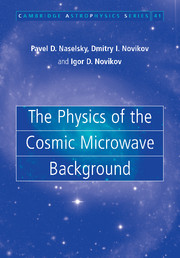Book contents
- Frontmatter
- Contents
- Preface to the Russian edition
- Preface to the English edition
- 1 Observational foundations of modern cosmology
- 2 Kinetics of electromagnetic radiation in a uniform Universe
- 3 The ionization history of the Universe
- 4 Primordial CMB and small perturbations of uniform cosmological model
- 5 Primary anisotropy of the cosmic microwave background
- 6 Primordial polarization of the cosmic microwave background
- 7 Statistical properties of random fields of anisotropy and polarization in the CMB
- 8 The Wilkinson Microwave Anisotropy Probe (WMAP)
- 9 The ‘Planckian era’ in the study of anisotropy and polarization of the CMB
- 10 Conclusion
- References
- Index
7 - Statistical properties of random fields of anisotropy and polarization in the CMB
Published online by Cambridge University Press: 18 August 2009
- Frontmatter
- Contents
- Preface to the Russian edition
- Preface to the English edition
- 1 Observational foundations of modern cosmology
- 2 Kinetics of electromagnetic radiation in a uniform Universe
- 3 The ionization history of the Universe
- 4 Primordial CMB and small perturbations of uniform cosmological model
- 5 Primary anisotropy of the cosmic microwave background
- 6 Primordial polarization of the cosmic microwave background
- 7 Statistical properties of random fields of anisotropy and polarization in the CMB
- 8 The Wilkinson Microwave Anisotropy Probe (WMAP)
- 9 The ‘Planckian era’ in the study of anisotropy and polarization of the CMB
- 10 Conclusion
- References
- Index
Summary
Introduction
In this chapter we concentrate on testing the statistical properties of anisotropy and polarization fields generated by primary perturbations of density, velocity and gravitational potential in the hydrogen recombination epoch. The main working hypothesis on which both the modern theory of structure formation in the Universe and the theory of generation of primordial anisotropy and polarization are based is the assumption of the random nature of the distribution of values of amplitude and phase of the primordial perturbations.
We need to emphasize that the idea of the random nature of primordial perturbations was introduced into cosmology long before it was ultimately explained in terms of inflationary models. In a certain sense, this idea reflects the fact that the distribution of matter in the Universe on spatial scales exceeding 102 Mpc is on average uniform and isotropic. If the formation of structures in different parts of the Universe separated by distances greater than 102–103 Mpc occurred independently of one another, it is then only natural to assume that the primordial distributions of the density, velocity and gravitational potential perturbations were once equally independent. Moreover, we know that non-linear in amplitude perturbations of density resulting from condensation of matter on smaller scales also evolved from small fluctuations.
- Type
- Chapter
- Information
- The Physics of the Cosmic Microwave Background , pp. 179 - 215Publisher: Cambridge University PressPrint publication year: 2006

